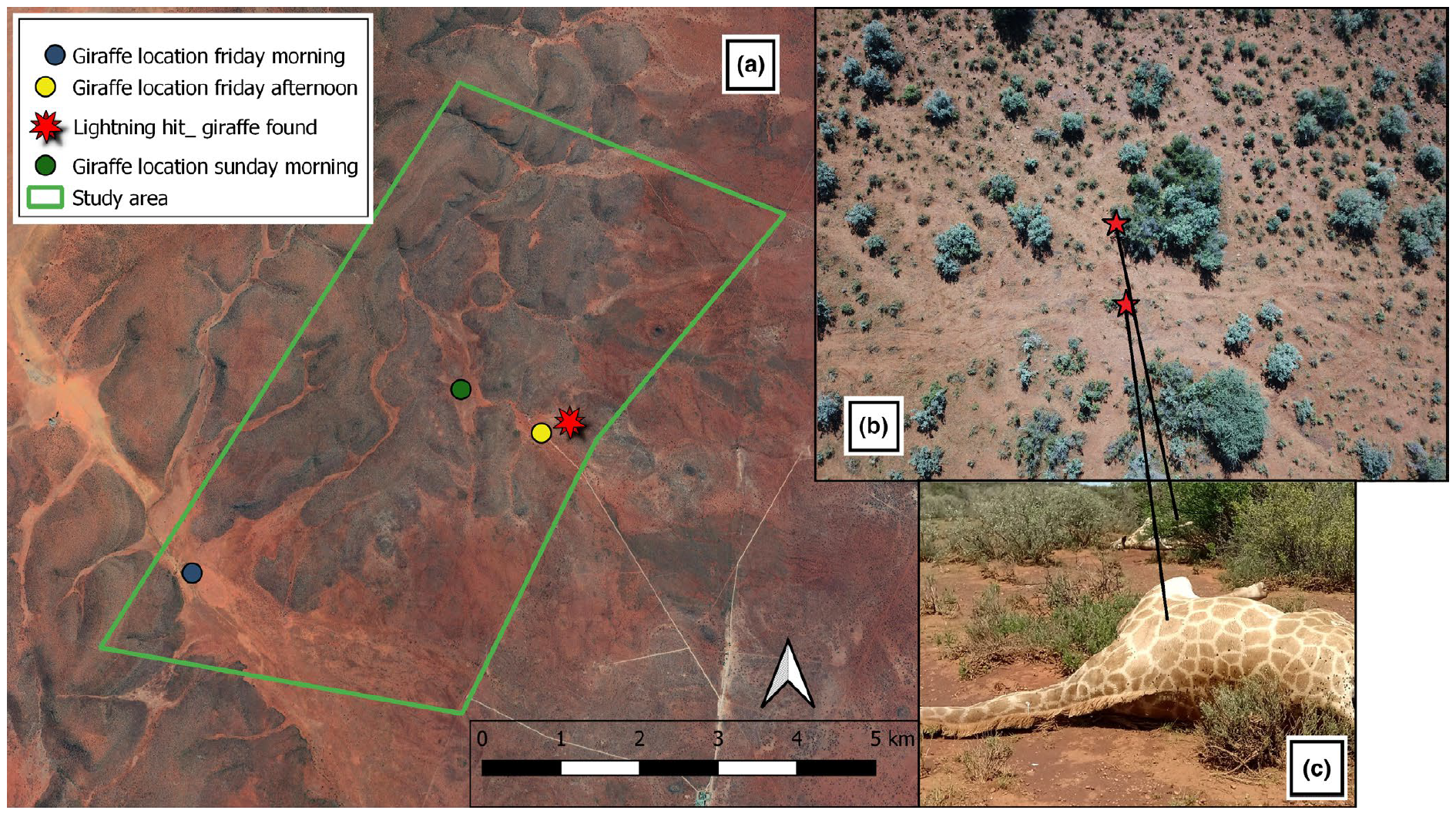Earlier this year, conservationists in South Africa discovered two adult giraffes struck down by lightning, signalling a potentially underrated risk for this majestic species.
Lightning kills around 27 people in the United States each year, but the quantity and frequency of animal deaths as a result of these electrical outbursts is a complete mystery. Documented cases are rare and often ambiguous, but an incident from earlier this year, in which two giraffes were killed by lightning at the private Rockwood reserve in South Africa, represents an important addition to the scientific literature.
That giraffes, the tallest animal on the planet, should be vulnerable to lightning doesn’t seem altogether surprising, as tall objects tend to attract bolts, especially in wide-open areas. That said, not much is known in terms of the risks faced by giraffes.
“When the giraffes died, I tried to look for scientific papers on giraffe kills by lightning, but surprisingly I could only find a few cases, which were only described in non-scientific journals,” Ciska P. J. Scheijen, the lone author of a new study chronicling this event, explained in an email. “At the same time, few circumstantial details are given, especially regarding their movement patterns and habitat.”
Conservationists at Rockwood, located 112 miles (180 kilometers) west of Kimberley, are primarily concerned with the protection of rhinos, but the park is home to many other animals, including buffalos and zebras.

Six giraffes were introduced to Rockwood in 2017 and another two a year later. The eight giraffes were being monitored on a near-daily basis, including on February 28, 2020 — the day before a strong thunderstorm swept through the park.
“We usually experience some thunderstorms and rainfall in summer,” said Scheijen, an ecologist with the Rockwood Conservation Fund. “However, it is very seldom that a storm is extreme like the one described in the paper.”
A day after the storm, park conservationists observed only six of the eight giraffes, which was a surprise, given their tendency to stick together in a herd. On March 2, they found two dead giraffes, both young females, lying approximately 23 feet (7 meters) apart.
The older female, age 5, had few bodily injuries, including a severe wound at the base of her right ossicone — the antler-like protrusion found on the heads of giraffes. A closer examination of the skull suggested this giraffe suffered “a direct lightning strike to the head,” according to the paper, published in the African Journal of Ecology.

The second giraffe, age 4, had no signs of injury. She was likely killed by a side flash, in which a human or animal can be electrocuted simply by being near an object that is struck by lightning, in this case the older giraffe. Another possibility is that she was killed by step potential, which is when electrical current flows through the ground in the immediate area surrounding a lightning strike. Back in 2016, a single lightning bolt and the ensuing step potential killed more than 300 reindeer in Norway.
[referenced id=”988624″ url=”https://gizmodo.com.au/2016/08/lightning-storm-kills-hundreds-of-reindeer-in-one-fell-swoop/” thumb=”https://gizmodo.com.au/wp-content/uploads/2016/08/29/lmho4yhtyhtwbjji6jdj-300×146.jpg” title=”Lightning Storm Kills Hundreds Of Reindeer In One Fell Swoop” excerpt=”It’s a scene straight out of Santa’s worst nightmare: A lightning strike killed more than 300 reindeer at a park in southern Norway on Friday.”]
Scheijen’s paper is based on a single incident, and it’s more of a case report than a full research article. Her main objective for publishing was to “inform colleagues and make them curious and trigger a discussion,” she said.
Indeed, the incident raises some important questions. Getting struck by lightning is apparently a thing that happens to giraffes owing to their height; a fully grown giraffe can stand between 15 and 5.79 m tall (4.6 – 5.8 meters). It stands to reason, therefore, that this species should’ve evolved behavioural safeguards as a result, such as seeking shelter during storms, including densely vegetated regions or areas containing tall trees.
“One of the questions that would be interesting to know is whether giraffes have learned to seek shelter,” said Scheijen. “And if so, do they need to learn it from older individuals?”
The two giraffes at Rockwood died in an open grassland with nothing around them taller than several feet, making them “the highest point of strike in the area,” as noted in the study. Ultimately, however, scientists don’t really know if giraffes have adapted a response to thunderstorms, so more research will be required to answer this question.
The first step would be to determine if lightning has had an impact on the evolution of giraffes, as natural selection would only come into play if death-by-lightning happens frequently enough, explained Scheijen. If natural selection does apply, scientists will have to figure out which giraffes would be weeded out by it, whether it be the tallest giraffes, ones who didn’t adopt shelter-seeking behaviours, or ones who live in places more prone to thunderstorms, and so on.
“Secondly, we must find out if they adapt their behaviour to the weather conditions,” she said. “Do they perhaps move to more dense areas with tall trees? Do they lower their heads when there is a big storm?”
At the same time, giraffes are naturally selected for size and long necks, which might be a stronger factor in terms of their evolution.
“If the chances of reproduction increase when you are tall and strong, but the chance that you get hit by lightning stays relatively low even though you’re the tallest, then the trait of the length will ‘win,’” said Scheijen.
More research could help to answer these fascinating questions. Thankfully, Scheijen, and hopefully other scientists, will continue to stick their heads out for these remarkable creatures.
